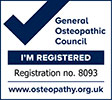Osteopathy is a system of diagnosis and treatment for a wide range of medical conditions. It works with the structure and function of the body, and is based on the principle that the well-being of an individual depends on the skeleton, muscles, ligaments and connective tissues functioning smoothly together.
To an osteopath, for your body to work well, its structure must also work well. So osteopaths work to restore your body to a state of balance, where possible without the use of drugs or surgery. Osteopaths use touch, physical manipulation, stretching and massage to increase the mobility of joints, to relieve muscle tension, to enhance the blood and nerve supply to tissues, and to help your body's own healing mechanisms. They may also provide advice on posture and exercise to aid recovery, promote health and prevent symptoms recurring.
(Source: GoSC website 2012)
Osteopathy is a 'hands on therapyʼ using treatment modalities such as:
Joint manipulation
Soft tissue massage techniques
Joint mobilisations (articulations)
Exercise therapy
Stretching techniques
There are many conditions that may be treated successfully with Osteopathy. These include:
Fibromyalgia
Sports injuries
Postural problems
Headaches arising from the neck (Cerviogenic)
Neck pain
Frozen or stiff shoulders
Rheumatic pain
Pain & stiffness associated with Osteoarthritis
Arthritic pain
Back pain including back pain in pregnancy
Tennis elbow
Arm, wrist & hand pain
Hip, thigh & knee problems
Calf, shin, ankle & foot pain
Neuralgia
Osteopathy is a patient-centred, system of healthcare. A first appointment generally lasts about 45 minutes to an hour to allow the osteopath adequate time to:
Listen and ask questions about your problem, your general health, other medical care you are receiving or medication you are taking, and record this in your case notes (the information you provide will be confidential);
Examine you properly. It is likely the osteopath will ask you to remove some of your clothing. Tell your osteopath if you are uncomfortable about this. You should expect privacy to undress and a towel should be provided. You can ask a friend or relative to accompany you and be present throughout your treatment;
Ask you to make simple movements and stretches to observe your posture and mobility. Because of the body's structure, pain or stiffness you are experiencing in one part may be linked to a problem elsewhere;
Examine the health of the joints, tissues and ligaments using their hands and a highly developed sense of touch called palpation.
Your osteopath will also check for signs of serious conditions they cannot treat and may advise you to see your GP or go to hospital. They should provide you with a letter explaining what they believe to be the problem.
(Source: GoSC website 2012)
The number of appointments needed will depend on your diagnosis. Your osteopath will be able to advise you on how many treatments you may require once they have reached a diagnosis.
Osteopaths are regulated by the General Osteopathic Council (GOsC). Osteopaths are legally required to be registered with GOsC in order to practice Osteopathy in the UK. www.osteopathy.org.uk


Sitemap| Website Design by 